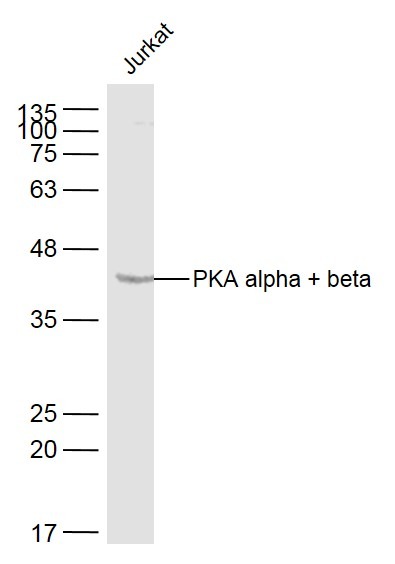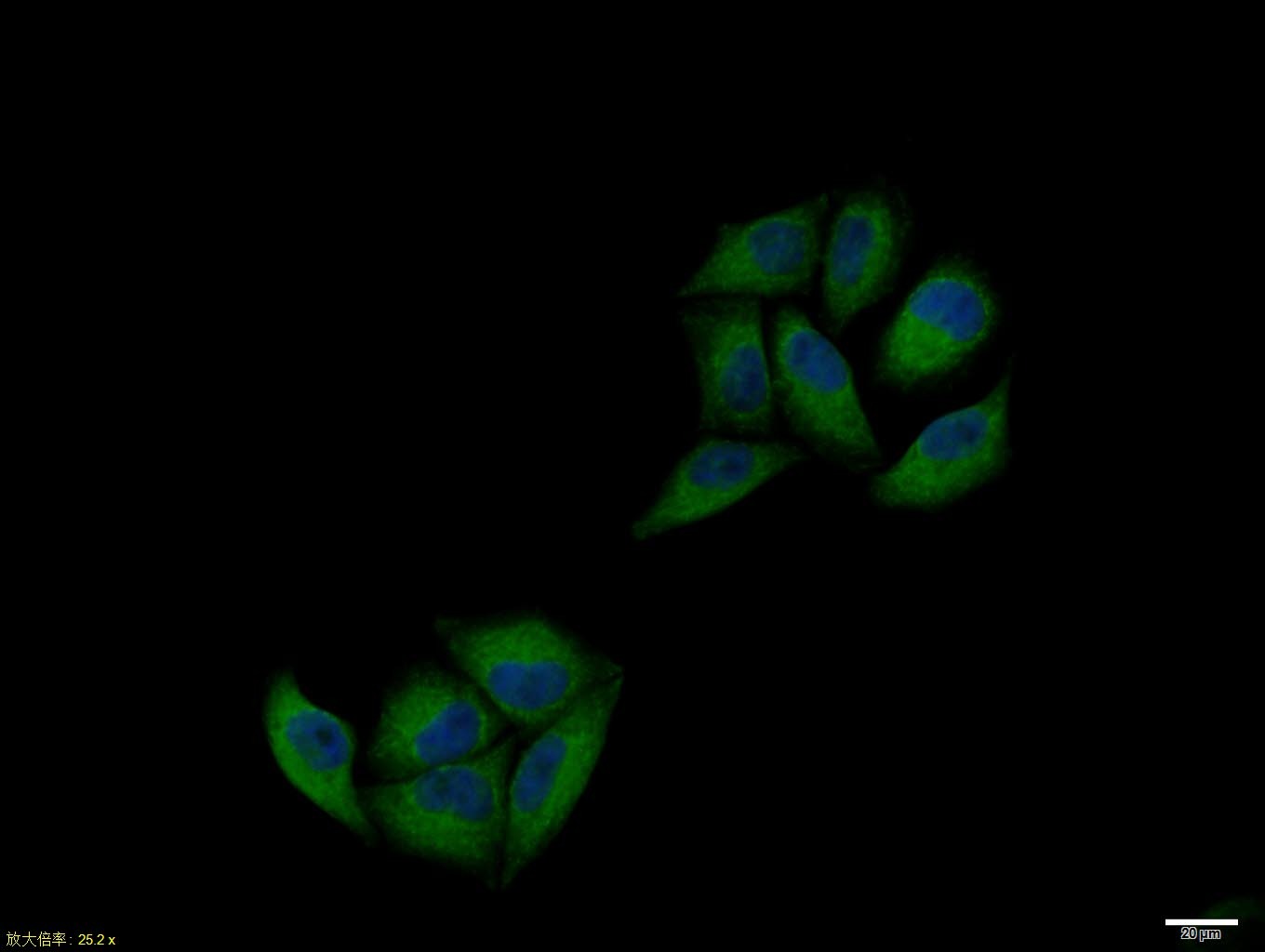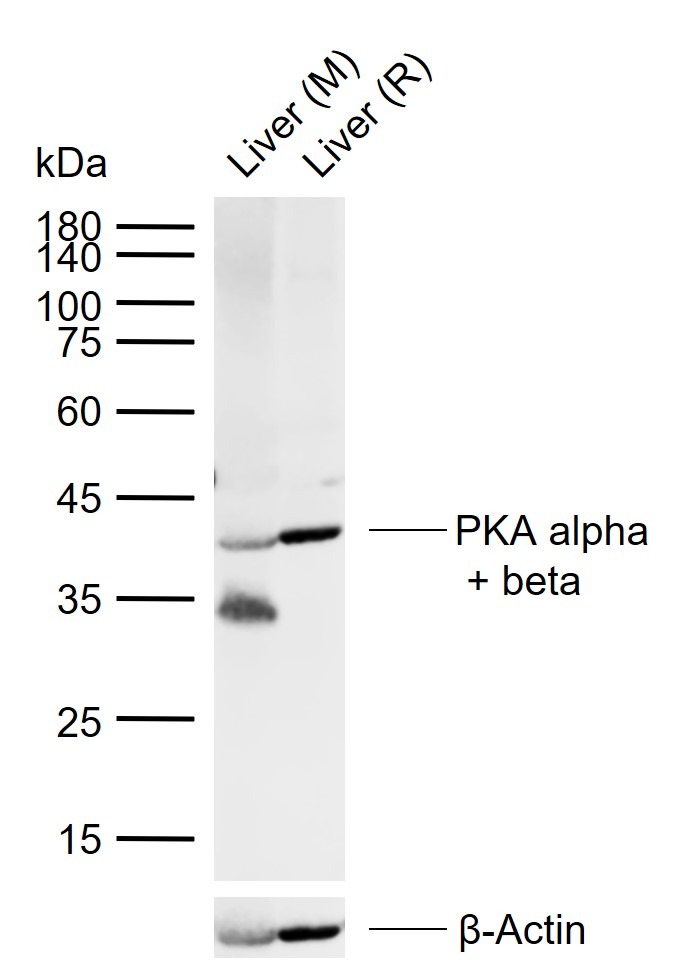Shopping Cart
Remove All Your shopping cart is currently empty
Your shopping cart is currently empty
Anti-PKA alpha/beta Polyclonal Antibody is a Rabbit antibody targeting PKA alpha/beta. Anti-PKA alpha/beta Polyclonal Antibody can be used in ICC/IF, WB.
| Pack Size | Price | USA Warehouse | Global Warehouse | Quantity |
|---|---|---|---|---|
| 50 μL | $220 | 7-10 days | 7-10 days | |
| 100 μL | $374 | 7-10 days | 7-10 days | |
| 200 μL | $529 | 7-10 days | 7-10 days |
| Description | Anti-PKA alpha/beta Polyclonal Antibody is a Rabbit antibody targeting PKA alpha/beta. Anti-PKA alpha/beta Polyclonal Antibody can be used in ICC/IF, WB. |
| Synonyms | Protein kinase cAMP dependent catalytic beta, Protein kinase cAMP dependent catalytic alpha, Protein kinase A catalytic subunit beta, Protein kinase A catalytic subunit alpha, Protein kinase A catalytic subunit, PRKACB, PRKACA+PRKACB, PRKACA/PRKACB, PRKACA, PKACB, PKACA, PKA C-alpha, PKA C beta, PKA C alpha, PKA beta, PKA alpha+beta, PKA alpha, MGC9320, MGC48865, MGC41879, MGC102831, KAPCB, KAPCA, DKFZp781I2452, cAMP-dependent protein kinase catalytic subunit alpha, cAMP dependent protein kinase catalytic subunit beta, cAMP dependent protein kinase catalytic subunit alpha isoform 1, cAMP dependent protein kinase catalytic subunit alpha, cAMP dependent protein kinase beta catalytic subunit, cAMP dependent protein kinase alpha catalytic subunit |
| Ig Type | IgG |
| Reactivity | Human,Mouse,Rat |
| Verified Activity | 1. Sample: Jurkat (Human) Cell Lysate at 40 μg Primary: Anti-PKA alpha + beta (TMAB-01543) at 1/300 dilution Secondary: IRDye800CW Goat Anti-Rabbit IgG at 1/20000 dilution Predicted band size: 40 kDa Observed band size: 40 kDa 2. Hela cell; 4% Paraformaldehyde-fixed; Triton X-100 at room temperature for 20 min; Blocking buffer (normal goat serum) at 37°C for 20 min; Antibody incubation with (PKA alpha + beta) polyclonal Antibody, Unconjugated (TMAB-01543) 1:100, 90 minutes at 37°C; followed by a conjugated Goat Anti-Rabbit IgG antibody at 37°C for 90 minutes, DAPI (blue) was used to stain the cell nucleus. 3. Sample: Lane 1: Mouse Liver tissue lysates Lane 2: Rat Liver tissue lysates Primary: Anti-PKA alpha + beta (TMAB-01543) at 1/1000 dilution Secondary: IRDye800CW Goat Anti-Rabbit IgG at 1/20000 dilution Predicted band size: 40 kDa Observed band size: 40 kDa    |
| Application | |
| Recommended Dose | ICC/IF=1:100-500; WB=1:500-2000 |
| Antibody Type | Polyclonal |
| Host Species | Rabbit |
| Subcellular Localization | oplasm. Cell membrane. Nucleus (By similarity). Note=Translocates into the nucleus (monomeric catalytic subunit) (By similarity). The inactive holoenzyme is found in the cytoplasm (By similarity). |
| Tissue Specificity | Isoform 1 is most abundant in the brain, with low level expression in kidney. Isoform 2 is predominantly expressed in thymus, spleen and kidney. Isoform 3 and isoform 4 are only expressed in the brain. |
| Construction | Polyclonal Antibody |
| Purification | Protein A purified |
| Appearance | Liquid |
| Formulation | 0.01M TBS (pH7.4) with 1% BSA, 0.02% Proclin300 and 50% Glycerol. |
| Concentration | 1 mg/mL |
| Research Background | cAMP is a signaling molecule important for a variety of cellular functions. cAMP exerts its effects by activating the cAMP dependent protein kinase (AMPK), which transduces the signal through phosphorylation of different target proteins. The inactive holoenzyme of AMPK is a tetramer composed of two regulatory and two catalytic subunits. cAMP causes the dissociation of the inactive holoenzyme into a dimer of regulatory subunits bound to four cAMP and two free monomeric catalytic subunits. Four different regulatory subunits and three catalytic subunits of AMPK have been identified in humans. PKA beta (catalytic subunit) is a member of the Ser/Thr protein kinase family and is a catalytic subunit of AMPK. |
| Immunogen | KLH conjugated synthetic peptide: human PRKACA/PRKACB |
| Antigen Species | Human |
| Gene Name | PRKACA |
| Gene ID | |
| Protein Name | cAMP-dependent protein kinase catalytic subunit alpha |
| Uniprot ID | |
| Biology Area | Integration of energy metabolism,Metabolism of lipids and lipoproteins,Serine/threonine kinases,Integration of energy,Lipid metabolism,Cancer,Kinases,PKA,PKC |
| Function | Mediates cAMP-dependent signaling triggered by receptor binding to GPCRs. PKA activation regulates diverse cellular processes such as cell proliferation, the cell cycle, differentiation and regulation of microtubule dynamics, chromatin condensation and decondensation, nuclear envelope disassembly and reassembly, as well as regulation of intracellular transport mechanisms and ion flux. Regulates the abundance of compartmentalized pools of its regulatory subunits through phosphorylation of PJA2 which binds and ubiquitinates these subunits, leading to their subsequent proteolysis. |
| Molecular Weight | Theoretical: 40 kDa. |
| Stability & Storage | Store at -20°C or -80°C for 12 months. Avoid repeated freeze-thaw cycles. |
| Transport | Shipping with blue ice. |
| Size | Quantity | Unit Price | Amount | Operation |
|---|

Copyright © 2015-2026 TargetMol Chemicals Inc. All Rights Reserved.